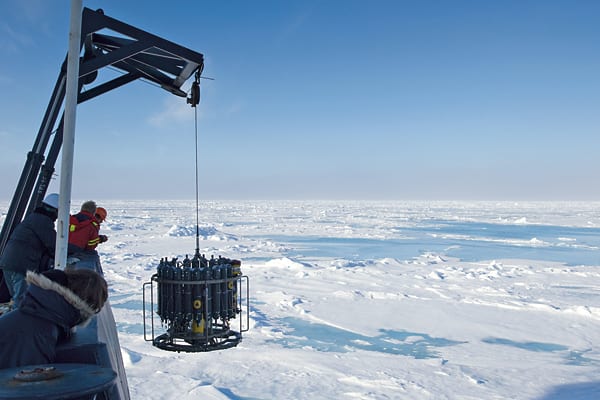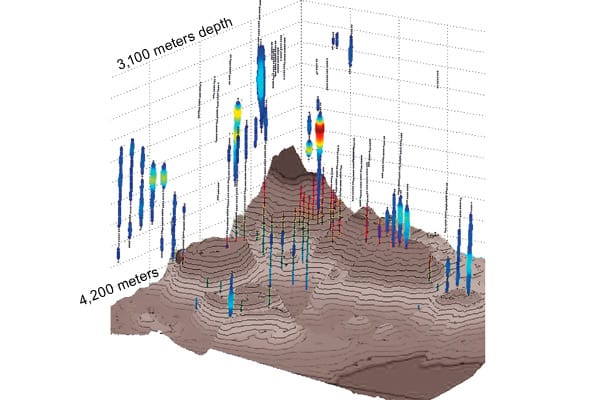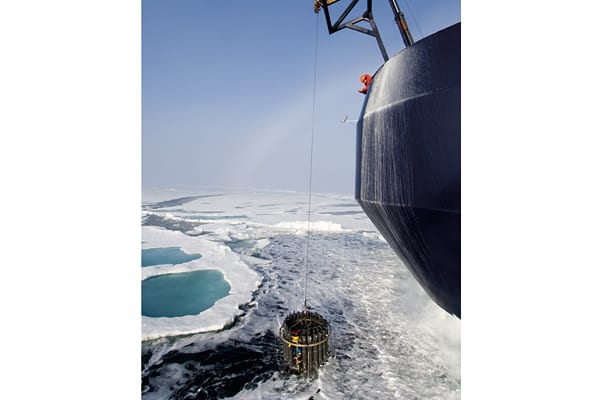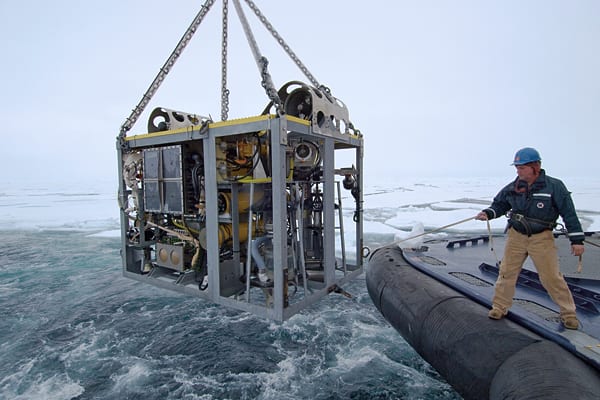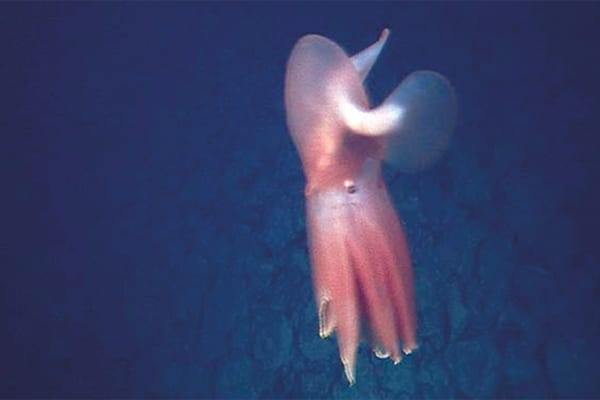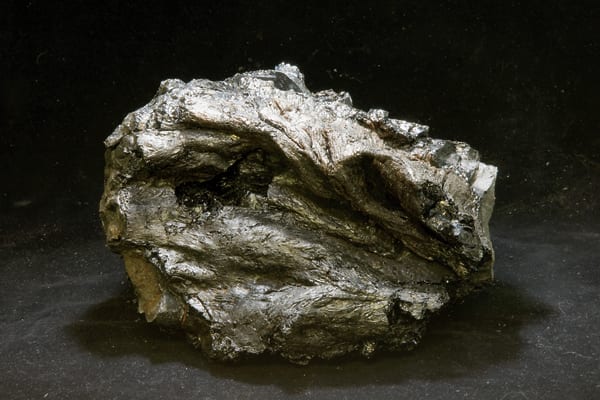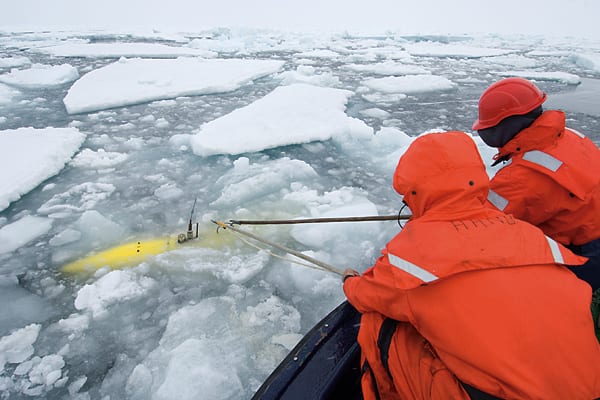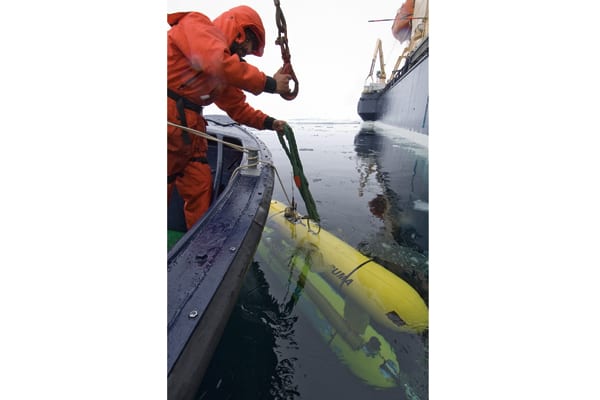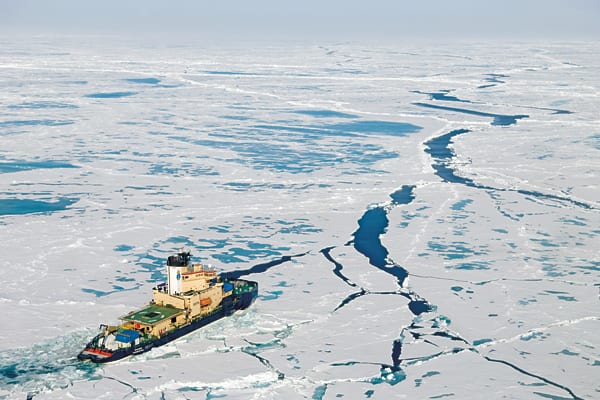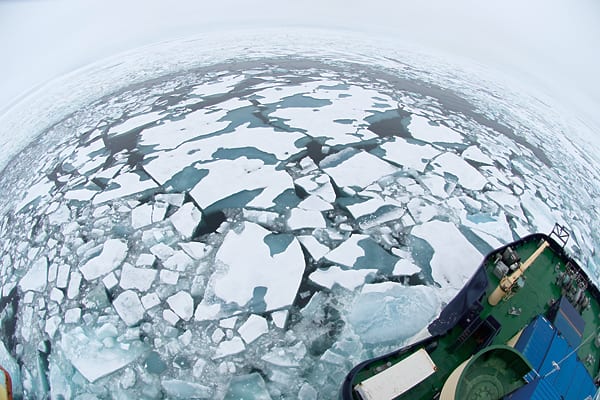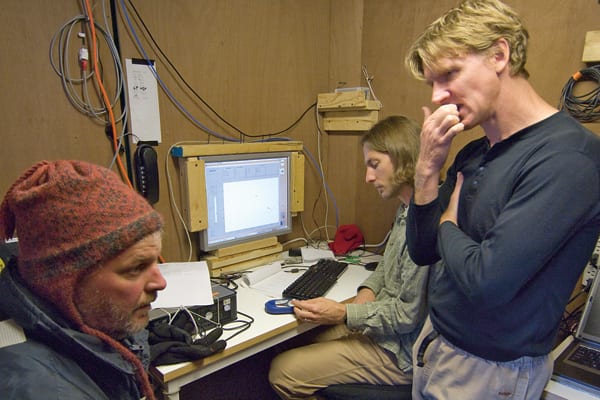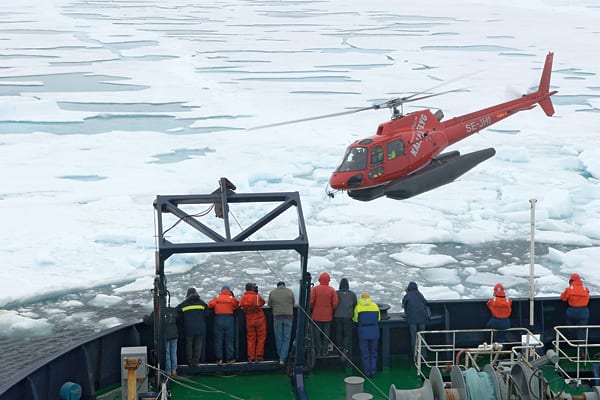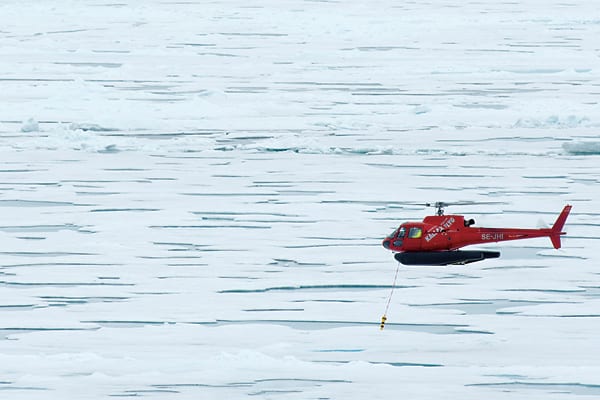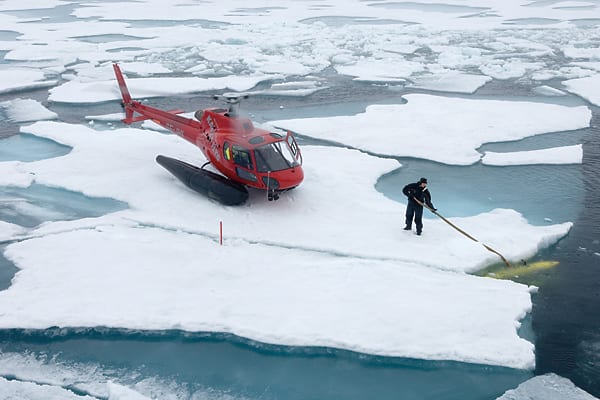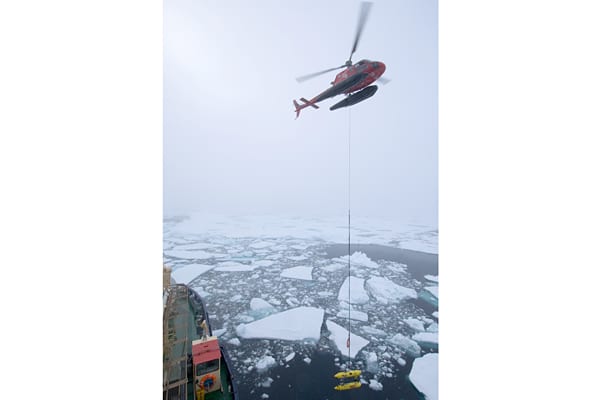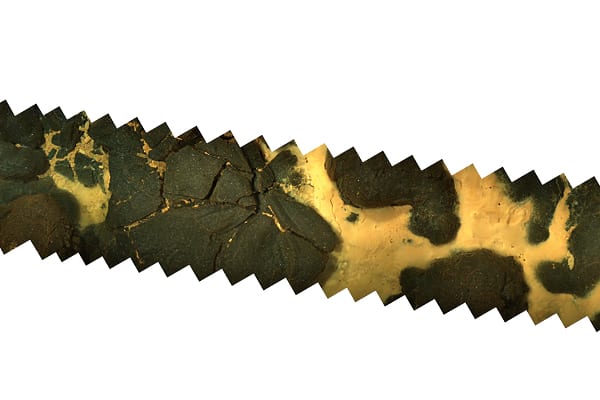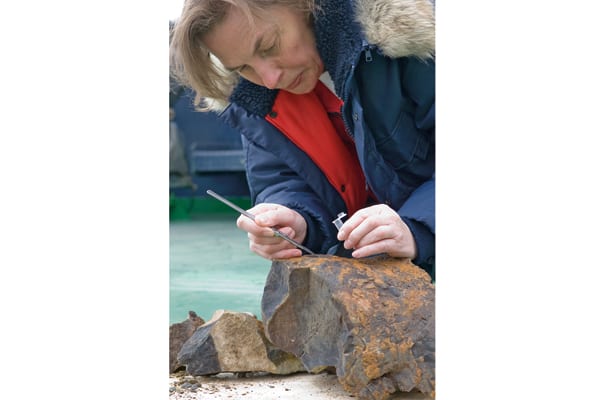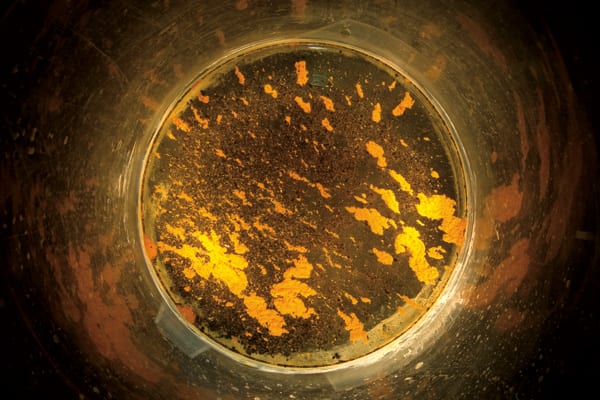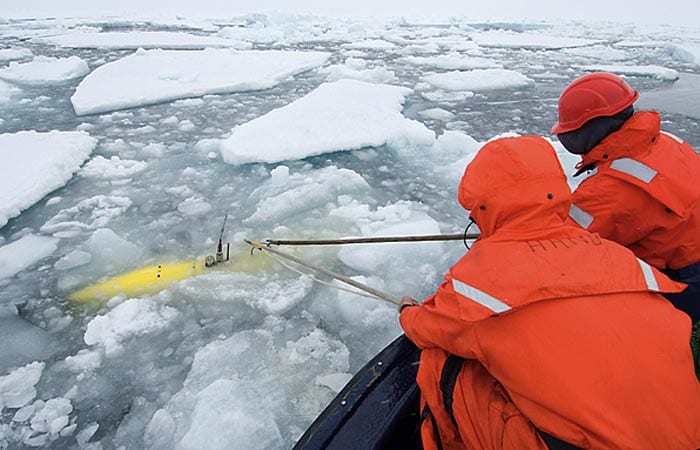
Arctic Voyage Tests New Robots for Ice-covered Oceans
Putting untethered vehicles under the ice cap is one thing. Getting them back is another.
In the summer of 2007, an international team led by scientists at Woods Hole Oceanographic Institution sailed to the Arctic Ocean aboard the Swedish icebreaker Oden. Their missions: to test new robotic vehicles designed for use in ice-covered oceans and to search for volcanic activity and new deep-sea life forms on the previously unexplored Gakkel Ridge. Thousands of people followed daily dispatches of the unfolding expedition on two WHOI Web sites:
Dive and Discover (www.divediscover.whoi.edu/expedition11)
and Polar Discovery (www.polardiscovery.whoi.edu/expedition2).
From a Warm Bath to an Ice-covered Ocean
(from Dive and Discover, July 1, 2007)
This story begins on a moon of Jupiter and in a bathtub.
The bathtub was on Earth, and in it was Cassidy Reves-Sohn, just a few months old and being scrubbed by her dad, Rob. As is often the case in these situations, the tub was full of soap bubbles and bobbing toys, including a Sesame Street submarine, captained by none other than Elmo.
If you’ve ever been a parent giving your kid a bath, or a kid being given one, you know that bath times are also full of fantasy. No one knows what Cassidy was fantasizing about. But to her father—an earth scientist who studies the seafloor—the white layer of bubbles suddenly reminded him of the sea ice that covered the Arctic Ocean—and blocked scientists’ ability to get to the bottom of it. Wouldn’t it be neat, Reves-Sohn thought, if we had vehicles that could safely explore below the ice and resurface again, as easily as Elmo’s sub?
That was ten years ago, about the same time that the space vehicle Galileo, orbiting a moon of Jupiter called Europa, found that the moon’s surface was an ice-covered ocean. Space scientists also calculated that the massive gravitational forces exerted by Jupiter on its tiny moon likely caused volcanic activity on Europa.
It was only 20 years before that, in 1977, that scientists had discovered, much to their astonishment, that those same two ingredients—volcanism beneath an ocean—created conditions for life to thrive on Earth.
Along the Earth’s volcanic mid-ocean ridges, seawater seeped through cracks in the seafloor and were heated by volcanic rocks below. The heated seawater chemically reacted with rocks and rose like geysers on the seafloor. These so-called hydrothermal vents discharged chemical-rich fluids that sustained lush communities of life in the absence of sunlight.
If such life were possible on Earth, why not on Europa? Jupiter’s moon became a prime future target for space scientists to search for extraterrestrial life in our solar system.
Meanwhile, to earth scientists like Rob Reves-Sohn, the bottom of the Arctic seemed almost as remote, inaccessible, and unexplored as Europa. In the mid-1990s, around the same time as Cassidy’s bath, the U.S. Navy for the first time offered nuclear submarines to the scientific community for unclassified Arctic research. A few submarine missions used sonar to make maps of the Gakkel Ridge beneath the eastern Arctic Ocean.
It wasn’t until 2001 that scientists secured an icebreaker for the first research cruise dedicated to sampling the Gakkel Ridge. The ridge was not supposed to be very volcanic, so the scientists were surprised when they found strong evidence of plumes from hydrothermal vents.
Now the threads of these stories come together. Rob Reves-Sohn, working with engineers at WHOI, followed his dream to develop robotic underwater vehicles that could explore beneath the Arctic Ocean. The National Aeronautics and Space Administration (NASA) was interested in developing robots that someday could search for life beneath ice-covered oceans on planetary bodies such as Europa. And earth scientists were eager to return to the Gakkel Ridge with vehicles that could find and explore hydrothermal vents, and possibly undiscovered life forms around them.
NASA funded development of experimental under-ice vehicles, and the Arctic offered a real-life, Europa-like environment to test them. The National Science Foundation funded an expedition, with Reves-Sohn as chief scientist, to try to use these experimental vehicles to explore the Gakkel Ridge.
And that, in a nutshell, is how we all got to Svalbard, an island above the Arctic Circle, from which we set sail yesterday aboard the Swedish icebreaker Oden, headed into the ice pack toward the Gakkel Ridge.
The hunt for red hot hydrothermal vents
Hot, mineral-rich fluids gush from hydrothermal vents on the seafloor. To search for vents and the animals that live around them, scientists floating atop the ice-choked Arctic Ocean first look for plumes of fluids that trail out from the vents and drift in the depths.
“Plumes are a little bit like smokestacks from factories,” said Hanu Singh, a scientist in the WHOI Applied Ocean Physics and Engineering Department who led a five-year effort to build new deep-sea vehicles for under-ice operations. “The smokestack has a diameter of only a few meters. But as it spews out smoke, the smoke usually rises up in a straight line vertically, and then it starts spreading out horizontally over large areas. Hydrothermal vent plumes work similarly and can lead us back to their source.”
It isn’t easy. “Picture this,” the July 6 dispatch on Dive and Discover read. “There is a group of people you want to find. They are huddled around a small campfire. The campfire is in an impenetrable desert so you can’t walk in. Your only hope is to fly a helicopter above the desert to see if you can spot the smoke from the campfire. But thick fog hovers a few miles above the desert. …So you put a thermometer and a smoke detector on a long wire that you lower down through the fog in a place where you think there might be smoke, and then you hope your tiny instruments run into it.”
At the mercy of the ice
Sending an untethered robot into the depths is relatively simple. Bringing it back from beneath the ice was daunting.
In most oceans, deep-sea vehicles rise to the surface after completing their missions and are recovered by ships. The Arctic Ocean ice pack, up to 4 meters (13 feet) thick, proved a formidable, relentless, and unpredictable obstacle. Ensuring that the vehicles did not get lost or trapped under the ice, or damaged by it, was “a difficult technological task,” said Rob Reves-Sohn, the expedition’s chief scientist.
“Nobody’s ever done that before, so we didn’t have much experience,” he said. “You can plan and plan and plan, but you don’t know what will happen until you actually do it. We knew the vehicles had a very real chance of failing, and even being lost under the ice.”
WHOI engineer Hanu Singh said: “We have a saying in the underwater world: ‘The number of vehicle deployments should equal the number of recoveries.’ ”
Intriguing discoveries
In the end, the researchers did not find hydrothermal vents, but they did discover curious mats of yellowy-orange “fluff”—composed of microbes and/or material made by microbes, perhaps fed by a weak flow of chemical-rich fluids seeping out of the seafloor.
Slideshow
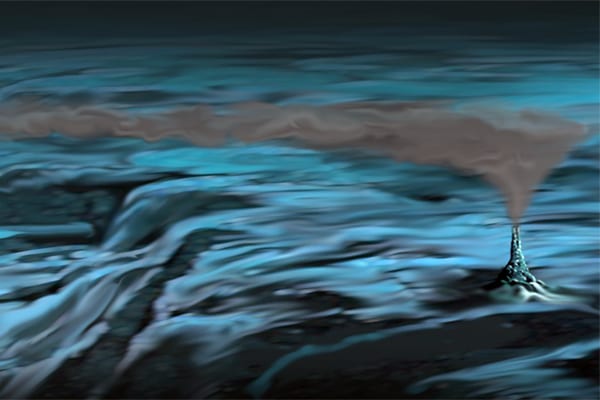
Slideshow
 Hot, mineral-rich fluids gush from hydrothermal vents on the seafloor. To search for vents and the animals that live around them, scientists floating atop the ice-choked Arctic Ocean first look for plumes of fluids that trail out from the vents and drift in the depths. (Illustration by E. Paul Oberlander, WHOI)
Hot, mineral-rich fluids gush from hydrothermal vents on the seafloor. To search for vents and the animals that live around them, scientists floating atop the ice-choked Arctic Ocean first look for plumes of fluids that trail out from the vents and drift in the depths. (Illustration by E. Paul Oberlander, WHOI)- STEP 1: ?TOW-YO-ING' FOR PLUMES?For oceanographers, the thermometer and smoke detector hanging down is called a CTD, which measures conductivity (salinity) and temperature at various depths. This tried-and-true instrument is scientists? first tool to look for hydrothermal plumes. The CTD is lowered all the way to the bottom and pulled up again while it is also towed by the ship, which researchers call a ?tow-yo.? CTD sensors detect slightly warmer temperatures, mineral particles, and certain chemicals?all telltale signs that the CTD has passed through a plume. ?It?s hit or miss,? said University of Texas marine geochemist Hedy Edmonds, who headed CTD operations on the expedition.
- Still, with a little luck and a lot of experience, over many CTD casts, scientists constructed a map of water over the seafloor, showing areas (yellow and red) with suspected plume fluids.
- WHOI physical oceanographer Peter Winsor peers over the massive bow of the icebreaker Oden as an instrument called a ?CTD? is dangled into the ice-covered Arctic Ocean depths. Arching behind his head is a fogbow, a common Arctic meteorological phenomenon caused by sunlight refracting water droplets in a fog bank.
- STEP 2: UNLEASH THE ROBOTIC 'CATS'?WHOI engineers built three new vehicles to search for hydrothermal vents beneath the Arctic Ocean. The first two are sleek, torpedo-shaped, free-swimming robots called Puma and Jaguar. Once the CTD provides a rough idea of where a plume is, Puma is deployed through a hole in the ice and programmed to conduct missions on its own, said WHOI engineer Hanu Singh (left, with MIT/WHOI graduate student Clay Kunz, right). Equipped with sonar and sensors to ?sniff out? telltale temperature, chemical, or particle signals of hydrothermal plumes, it is designed to help scientists track the plume to its vent source.
- Jaguar is deployed next, using sonar to create seafloor maps (above) and to home in on vents, hovering above them while its camera and lighting systems collect images of the vents and any animals living around them.
- STEP 3: A DEEP-SEA CAMPER?The third new under-ice vehicle, designed and built by WHOI engineers led by John Bailey, is called Camper (short for ?camera/sampler?). Above, WHOI engineer John Kemp guides Camper into an ice-free pool created by the icebreaker Oden. The 6,200-pound steel-frame box?5 feet wide, 7 feet long, and 5.5 feet tall?is towed behind the icebreaker, which drifts with the ice pack. Camper is lowered to the seafloor via a winch and a fiber-optic cable.
- Camper is equipped with camera and light systems to send real-time images, such as this deep-sea octopus, back to scientists aboard ship.
- Researchers can send commands to the vehicle?s thrusters to maneuver and hover Camper briefly over vent sites and to operate its samplers: a ?grabber? to snatch hard samples such as clams or rocks (above) and a ?slurp gun? to vacuum in samples of fluids or microbes.
- On a clear day, recovering an underwater vehicle could be relatively easy. ?Clear,? in this case, referred not to the sky, but to the ocean. Using sound signals, scientists guided the robotic vehicle Puma to surface in a calm, open pool of water in the ice pack and head right toward WHOI engineer John Kemp in a crane-operated basket, almost like a good dog coming home to poppa (left). Oden?s Able Seaman Stefan Borstad crooked the crane?s elbow as far down as it could go and extended its forearm to get the basket as close as possible to the water line. Kemp reeled in Puma, and Borstad reeled in Kemp.
- Clear days were rare, however, and most recoveries posed nerve-wracking challenges. More ice required more maneuverability, so Oden?s small boat, Hugin, was dispatched to find and recover vehicles surfacing in the ice pack.
- WHOI researchers Hanu Singh and Mike Jakuba secure Puma by ropes to Hugin, which towed the robot back to Oden.
- Singh attaches Puma to Oden?s crane for hoisting back on board the icebreaker.
- From Polar Discovery, July 21, 2007: Sometime after 7 a.m. Friday, about 3,700 meters, or 2.3 miles, under the Arctic Ocean ice cap, the robotic vehicle Puma lost a thruster on a mission to search for plumes from hydrothermal vents on the seafloor. Scientists, engineers, and the crew of the icebreaker Oden all mobilized to try to get the hobbled vehicle back to the surface, to guide Puma to a rendezvous with Oden in the shifting ice pack, and to make a hole in the densely packed ice for Puma to surface safely.
- With Oden?s master, Mattias Peterson, directing operations, and its second officer, Thomas Stromsnas, working the ship?s controls, the icebreaker mashed broken chunks into smaller pieces. In this fish-eye lens view, you can see how the ship circled the pieces, herding them into the center. The ship then tried to push the pieces to one side, to clear a patch of open water for Puma. But the ice pack was unforgiving today. The ice moved backed quickly, filling the hole again, and swarming the ship?s hull.
- Meanwhile, MIT/WHOI graduate student Clay Kunz (center) and others on the autonomous underwater vehicle (AUV) team were holed up in the AUV control van, calculating Puma?s slow ascent, tracking its position, and nudging the vehicle via computer commands toward Oden. The drama took hours to unfold. Chief Scientist Rob Reves-Sohn?s cuticles paid a price. ?I wish fingernails grew faster,? he said. WHOI engineer John Kemp (left) gets an update on the situation.
- When Puma nears the ship, the ship?s transponders can no longer pick it up well, leaving the AUV team unable to locate it precisely. WHOI scientists Susan Humphris and Tim Shank and helicopter pilots Sven Stenvall and Geir Akse were dispatched with a receiver that could hear a sound beacon on Puma?a device normally used to locate people trapped under avalanches. Stenvall flew the helicopter around the boat with the receiver dangling by a cable just above the ice, listening for telltale signals from Puma, somewhere nearby and under the ice. Then Shank spotted Puma?s blinking strobe light and a bit of its yellow ?skin? in a tiny gap between ice floes, hugging Oden?s hull on the portside bow.
- There?s a joke aboard ship that John Kemp will miss no opportunity to get into a ship?s crane-operated metal basket. Oden?s chief officer, Ola Andersson, lowered the basket toward the ice, reaching slightly underneath the ship and along its hull. For several tense minutes, neither Kemp nor anyone else saw Puma, and we wondered if it had disappeared under the ice or under the ship. Then Japan?s National Institute of Advanced Science and Technology geochemist Ko-ichi Nakamura saw Puma?s nose peeking out from under an ice floe. Andersson maneuvered Kemp toward it. With a long metal pole, Kemp pushed aside ice floes to free Puma. Nearly 22 hours after he had let Puma loose, Kemp grabbed hold of it again and brought it back on board.
- Two days later, Puma?s robotic sibling, Jaguar, surfaced somewhere under a seemingly endless blanket of white. Oden?s helicopter flew low, dangling a receiver just above the ice to listen for a sound signal from Jaguar. After more than an hour, a signal finally came. Pilot Sven Stenvall dropped a red-painted piece of wood on the ice to mark Jaguar?s location underneath. Oden broke ice and up popped Jaguar. Mattias Peterson, Oden?s captain, expertly and gingerly maneuvered the icebreaker toward it, trying to avoid accidentally running over it, pushing damaging ice floes into it, or stirring up the ice too much and losing the vehicle again.
- WHOI engineer John Kemp (red suit) and Ulf Hedman, expedition leader from the Swedish Polar Research Secretariat, were lowered in a metal basket to the ice to recover Jaguar. Each man was armed: Hedman with a shotgun in case of polar bear; Kemp with a pole and a rope and safety harness so he could jump safely from one ice floe to another. But by the time they reached the ice, Jaguar had suddenly disappeared again, and they could not relocate it.
- More fretful hours passed, but at last, a crack opened in a large ice floe that had pinned Jaguar. Stenvall landed on the floe, and co-pilot Geir Akse hooked a line to Jaguar (note the red marker).
- Oceanographers often say their underwater vehicles ?fly? through the ocean above the seafloor. Jaguar flew through the air. The helicopter delivered it to a pool of open water near Oden, where it was brought aboard as ice floes rushed in against the hull. During the expedition, Puma and Jaguar were launched eight times. To the relief and delight of WHOI scientists Rob Reves-Sohn and Hanu Singh, the number of recoveries equaled the number of deployments.
- Researchers spent the same amount of time aboard Oden as Noah spent on his ark: 40 days and nights (well, make that 40 days and no nights, MIT/WHOI graduate student Clay Kunz pointed out).
- A mosaic of images taken by Camper?s cameras shows yellow microbial mats lining the cracks between seafloor rocks.
- Camper also captured seafloor samples that scientists eagerly sought to analyze back in onshore labs. WHOI geochemist Susan Humphris (left) and WHOI biologist Tim Shank examine samples that just arrived on deck from the seafloor.
- Microbiologist Elisabeth Helmke from the Alfred Wegener Institute in Germany scrapes orange deposits from a Gakkel Ridge rock snatched up by Camper?s grabber.
- A glass beaker holds orange microbial material slurped up by Camper?s vacuum sampler, as well as tiny black shards of volcanic glass that covered large areas of the Gakkel Ridge seafloor. Chemical analyses of these may provide evidence of unusually explosive seafloor volcanism, which is rare under the tremendous pressure more than 2.5 miles below the ocean surface.
Related Articles
Featured Researchers
See Also
- Dive and Discover Expedition 11: Voyage to the Gakkel Ridge
- Polar Discovery Expedition 2: To the Arctic Seafloor
- Summer Under Arctic Ice A conversation with WHOI geophysicist Rob Reves-Sohn from Oceanus magazine
- Hanumant Singh's Lab

